how to drill into concrete
On this page I'll show you my simple and easy method for drilling into concrete. You can use my method for fastening, hanging, or securing many different things to concrete.
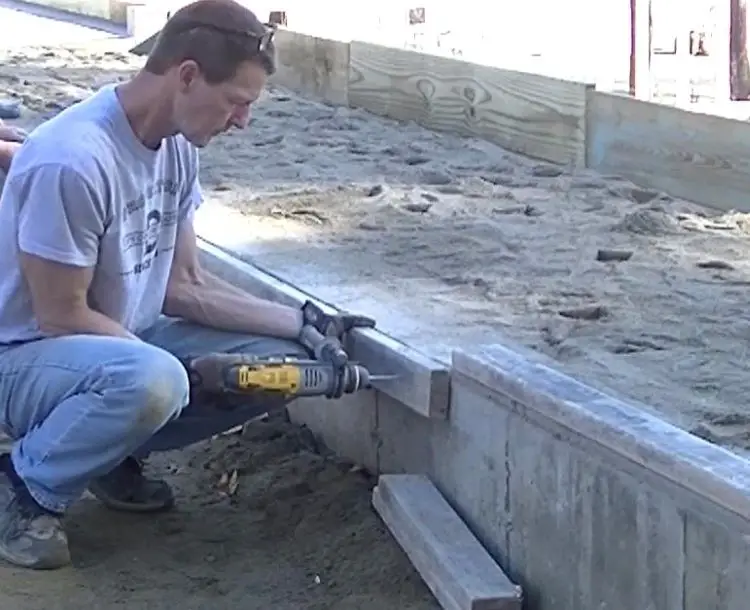 I'm drilling into a concrete wall using my Dewalt hammer drill and a masonry bit.
I'm drilling into a concrete wall using my Dewalt hammer drill and a masonry bit.TIME REQUIRED PER HOLE: Under a minute (varies depending how big the hole is)
DIFFICULTY: Easy to Moderate (small holes are quite easy, larger ones more difficult)
I'm always drilling into concrete to fasten boards like this. I use a Dewalt hammer drill and a masonry bit because I found it's faster than using a regular drill.
But if you only have a few small holes to drill, a regular drill will work as you'll see in the pictures below.
Depending on what you're doing, here's a few other tools that you may need:
step 1. before drilling into the concrete - mark your spot
|
If you need to be precise, it's a good idea to mark the spot you'll be drilling the hole. Most of the time a good pencil will work just fine, I also like to use a black sharpie, the color stands out more. If you're making multiple marks along the same line, this is where a 4' level comes in handy. |
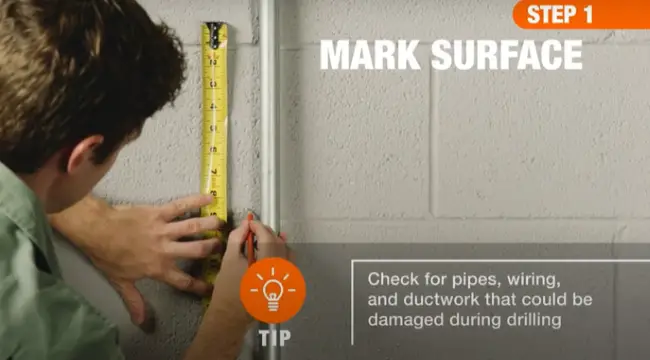 |
step 2. set-up the drill for drilling into concrete
|
To prepare your drill, set the depth control guide to your desired drilling depth. (if needed) Adjust the auxiliary handle for better control and leverage for when you start drilling. Insert and secure the correct size masonry bit for the screw or fastener you're using. |
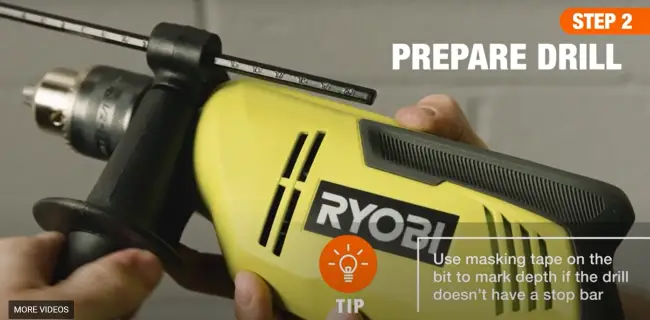 |
PRO TIP: If you're drill doesn't have a depth guide, just wrap some masking tape around the drill bit at the depth you need to go and use the tape as your depth guide for when to stop drilling.
how to drill into concrete with a regular drill - can you?
You can use a regular drill to drill into concrete. The main difference between a regular drill and a hammer drill is the hammer drill has a pulsating (hammer) action as it drills.
The pulsating action as you drill makes drilling concrete somewhat easier than just using a regular drill.
If you only have a few holes or less to drill, you should be able to do it with a regular drill. You just may have to push harder than if you were using a hammer drill.
step 3. drilling into concrete with exact precision - drill a guide hole
|
This is optional depending on how large of a hole you need to drill. Small holes 1/4 inch or less are pretty easy to get exactly precise. Larger holes 3/8" or more, sometimes the bit wants to run off center. This is when drilling a smaller guide hole first will make sure you drill into the concrete exactly where you want to. |
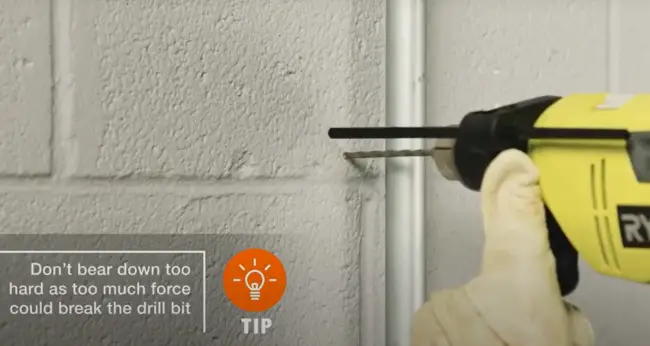 |
The guide hole doesn't have to go very deep, a 1/4 inch is enough. This smaller hole will give the larger masonry bit a firm starting point so the bit doesn't want to "walk" on you when you start drilling the hole.
PRO TIP: Only use enough pressure as you need to drill the hole. If you push too hard on a small drill bit, it could easily break in half.
Secondly, it's always a good idea to have more than one masonry bit for a backup in case you do end up breaking one.
step 4. drill into the concrete
|
Firmly grip your drill and align it perpendicular to what you're drilling into. Slowly squeeze the drills trigger and start drilling into the concrete. If you're using a regular drill, you'll have to push quite hard. If you're using a hammer drill, only slight pressure is needed for most holes. Drill until you reach your required depth. You may need to slightly push and pull the drill in an "in and out" action if the concrete is really hard. |
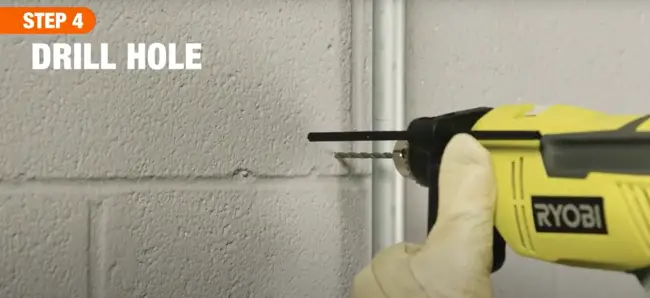 |
BE CAREFUL: Sometimes while drilling a "puff" of concrete dust will blow out of the hole. Make sure to wear your safety goggles and mask to protect yourself.
ALSO BEWARE: There may be embedded rebar in the concrete. If your drill bit hits a piece of rebar it will stop drilling and may even break.
step 5. cleaning concrete dust out of a drilled hole
Most of the time a wet/dry vacuum will work just fine for cleaning out all the concrete dust.
Sometimes I'll even run the drill bit back and forth into the hole while it's spinning. This pulls out some of the dust and loosens up the rest for the vacuum to clean out.
IF you need it really clean, then a compressed air sprayer with a needle tip works very good. Just have the vacuum on and in place when you spray air into the hole.
step 6. screw or fasten into your drilled concrete hole
|
Once your hole is drilled and cleaned out, you're ready to screw into it. (or use some other type of fastener) I like to use TAPCON screws for securing wood to concrete. (like I'm doing in the picture at the top of the page) |
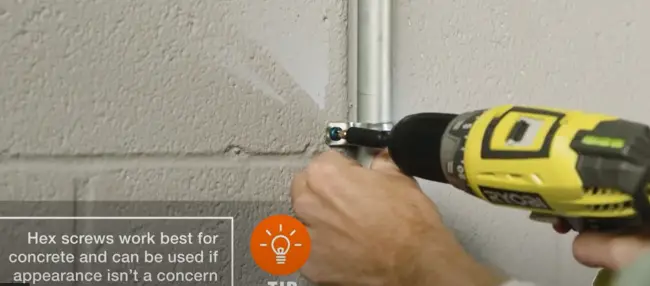 |
Tapcon screws come in many different sizes and lengths. They also come in multiple styles, colors, and finishes for whatever you need.
Here are some other types of concrete fasteners.
how to drill into a concrete wall, concrete block, a concrete floor, or a concrete ceiling
In most cases, I've found that drilling into a concrete wall, concrete blocks, concrete floors, or a concrete ceiling, pretty much the same process.
For my work, I'm always drilling into concrete walls and concrete floors. Occasionally I have to drill into concrete block but not as much as walls & floors.
Whether you're drilling vertical, into a wall, overhead into a ceiling, or down into a floor, your balance and leverage is very important for your safety. The drilling action for each is very similar.
Concrete blocks tend to be softer than regular ready-mix concrete walls and floors. When you drill into a concrete block be prepared to go very slowly at first.
After you see how the concrete block holds up to the drilling action, you can better determine how fast you need to operate your drill at.
PRO TIP: When using a Tapcon screw in a concrete block, go slowly as you screw into it. Once the screw is secure in place, don't over tighten it.
It's easier to "strip" out the hole in the softer concrete block material than it is in a concrete wall or floor.
what kind of drill bit do i need to drill into concrete?
The type of drill bits used to drill into concrete are called masonry bits. Masonry bits are designed with high strength carbide tips.
The carbide tips are very hard and can drill into concrete, cement blocks, bricks, and stone. The bits design helps it remove the dust as you drill into the concrete.
Most hammer drills use what's called a SDS masonry bit. You can get them here.
If you have a regular drill, use this type of masonry bit.
is the concrete dust from drilling bad to breath?
Breathing concrete dust is very bad for you. The dust made from drilling into concrete contains crystalline silica.
Crystalline silica dust particles are very small and sometimes invisible to the naked eye. When inhaled, even in small amounts, silica dust can cause lung health issues.
Silicosis is a disabling, irreversible, and sometimes fatal lung disease. It builds over time, with multiple exposures to breathing concrete dust.
It's best not to breath any of this dust if at all possible.
Use this special vacuum attachment made to collect the concrete dust when you drill into a concrete wall or ceiling.
The vacuum's suction will hold it in place and collect the dust while you drill through the opening.
CAN YOU DRILL INTO CONCRETE? ---- IS IT EASY FOR A BEGINNER
If you follow my step by step guide and don't rush, then you can drill into concrete even if you're a beginner.
The key to success is being prepared with knowledge, having the right tools, start drilling slowly, and hold the drill firmly throughout the entire drilling process.















